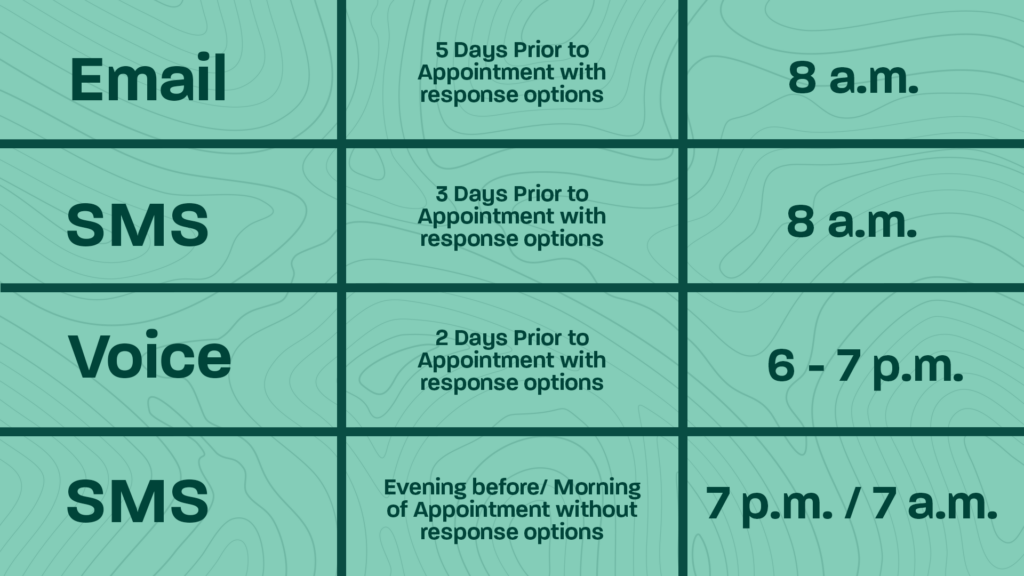Aligning to a new era of healthcare that places a premium on convenient, digital offerings—now considered as important as quality of care—has healthcare organizations adopting technology to help meet the evolving expectations of their patients. However, this shift brings about new challenges: how to optimize solutions and maximize their investment in patient communication.
How much patient communication is too much? How much is not enough?
The answer to the frequency question relies on several factors, both on the patient side and on the provider side. Over the course of care, patients will fall into numerous segments that require specific types of messages. For example, a new patient might receive intake paperwork as well as appointment reminders. An established patient may be requested to take a feedback survey. Or, perhaps, the practice has closed due to bad weather and all patients must be notified as soon as possible.
Typical segments for messaging include:
- New Patient
- Established Patient
- Chronic Condition Management
- Procedure/Imaging
- Follow-Up Visit
- Established Patient, New Problem
- Further segmentation based on specialty, condition, or need
Patients may be in multiple segments at the same time, or they may make progression through the segments. Optimal communication will vary based on condition, visit types, and place in the patient journey. In addition, the following factors should be taken into consideration:
- Patient preferences for messaging, be it email, phone, or text message
- Type of messaging that needs to be communicated, such as educational materials or clinical results
- The Federal Communications Commission cadence guidelines, like limiting hours when messages are sent
Too much communication would be to send daily messages across all available channels. Conflicting messages invalidate each other, whereas daily messages are eventually viewed as spam.
Too little communication is to send one singular, static message. Relying on a single message to be delivered and actioned on the spot leads to gaps in scheduling, an increase in no-shows, and a decrease in patient engagement.
An example of optimal frequency for a new patient is appointment reminders sent:

How can healthcare organizations make messages more impactful?
Each provider group can determine their segments and messaging pathways based on their patient population and existing assessment of their data.
In general, message content should be:
- Short and concise to prevent multiple messages due to phone carrier guidelines that break text over 250 characters into separate sends
- Informative, with the date of appointment, facility, name of provider, and a physical address
- Actionable, whether by link for appointment confirmation, to online self-scheduling options for rescheduling or cancelling, or to complete intake paperwork
While a recent survey found nearly 60% of provider groups are already using some type of outbound communication, a much smaller percentage are allowing for inbound communication. Expanding access and actions patients can initiate—online patient self-scheduling, chatbots, two-way texting—will greatly improve the impact of all types of patient segment communication.
How do organizations ramp up and maintain patient communication?
When implementing a sustainable and impactful patient communication program, providers should look for best-in-class patient scheduling and engagement technology that integrates with their practice systems, automates messaging to reduce resource investment, and offers configurable messaging to cover all segment needs.
Once this technology has been selected, an implementation expert should set the foundation for how to best approach a patient population. This may be first configuring appointment reminders—the messaging most likely to drive patient adoption and experience—and then optimizing a pre-existing cadence. For example, the optimal 5-3-2-1 messaging chart in the section above.
Over time, communication strategies should continue to focus on a practice’s business priorities. Perhaps patients are missing screenings, or there’s a new provider or service to advertise and subsequent schedule to fill. Next steps that practices should consider are:
- Assessing the modalities most used to realign messaging where it’s most seen
- Creating targeted health campaigns to close gaps in care and boost patient retention
- Layering in more opportunities for patients to self-manage their care journey with inbound communication channels
Best practices helped one clinic reduced their no-show rate from 10% to 5% with patient engagement
The South Bend Clinic, a multi-specialty provider group with 150 physicians, knew they needed to find a patient engagement solution that kept pace with its bustling clinic operations. After selecting a solution that integrated bi-directionally with their practice management system, NextGen, the clinic rapidly boosted appointment reminder messaging to cut no-show rate in half.
Communication technology foundational to patient communication programs
With emerging technology—such as online chat—continuing to redefine how, where, and when providers and patients interact, communication strategies should reflect these shifts. Read more about provider-patient communication best practices in The Comprehensive Guide to Better Patient Communication and Engagement.